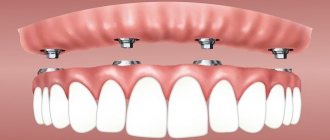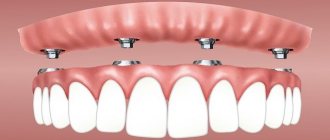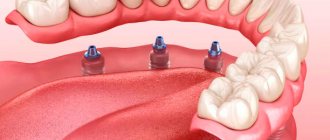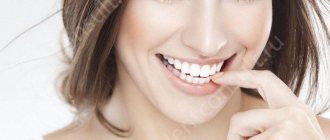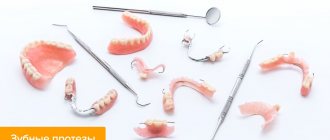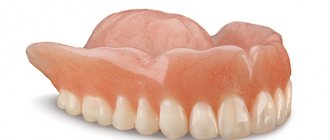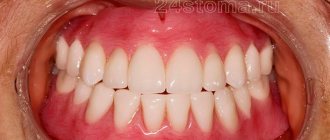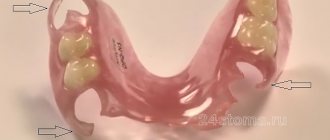Author of the article: Tsurkan Vladislav Gennadievich
Doctor-expert
Specialization: Dentist-orthopedist
Total work experience: since 2021
- Partially removable
Clasp
- QuattroTi
- Without sky
- Conditionally removable
- Which removable dentures are better?
With complete edentia
- With partial edentia
- For the upper jaw
- For the lower jaw
Restoring the dentition using removable dentures can be an alternative to fixed structures, especially when the latter have contraindications. To understand which type is suitable in your case, you need to know what removable dentures are available and how to choose the one that is best.
Artificial jaws: types
First of all, let's define the terminology to make the following text easier to understand.
- Basis - the base, which looks very similar to the gum, fits tightly to the oral cavity. The borders are made of modern polymer materials.
- Fastening – various locks with hooks securing the entire structure to supporting healthy organs.
- Implants are elements firmly embedded in the base, replacing individual chewing units. In production, light components are used that are as close in color to real teeth as possible.
Classification by type
Types are divided according to the substances contained in the composition. However, a distinction based on how partial dentures are placed, how they are inserted and secured, and what the dentures look like is the most correct approach.
Lamellar
The most inexpensive and accessible way to restore chewing functions. The plastic base completely covers the curves in the patient’s mouth and the contours of the gums. They are attached to supporting intact masticatory organs. Acrylic, nylon, and other modern materials that prevent allergic reactions are used in the production of these implants.
Low cost with simple fixation are the main advantages. The age group of patients for their use is not limited. However, the restoration of chewing functions does not occur completely; diction may be impaired, and the structure does not hold well in the mouth. The photo shows the installation of removable plate and one-sided dentures on hooks.
Clasp
Artificial analogues are attached to a metal frame. Since the base is made of durable material, the product will last quite a long time. Installed using various hooks, crowns and other methods.
This type of substitution is not suitable for those who have allergic reactions to the main component. High cost is also a significant disadvantage. Among the positive features are strength, strong fixation, complete restoration, natural appearance.
Immediates
They cannot be considered a permanent solution, as they are temporary measures. The installation of partially removable dentures is shown in the photo.
For a short period of time they can completely restore all aesthetic and chewing functions. But, it should be remembered that their use is only possible when one or two damaged units are restored.
Low cost along with quick installation are positive aspects. Soft components make the implant unstable to heavy loads and greatly reduce its service life. The use of immediates is common in dental practice when it is necessary to prevent the displacement of remaining teeth towards the removed ones.
Do-it-yourself prosthesis repair at home
The best way to repair a prosthesis is to contact a specialized laboratory technician. He will not only eliminate the defect, but also carry out preventive cleaning and correct the unbalanced basis. But situations arise when a visit to the dentist is simply impossible, so you can repair the structure at home.
The success of the procedure depends on the cause of the breakdown:
- poor quality and dentist errors;
- wear and tear of the material after the end of its service life ;
- abuse of crackers, nuts;
- gum subsidence.
At home, you can fix minor damage: a loose artificial molar, a chip on the base or a crack on the base. If deformation occurs due to subsidence of the gums, the appearance of a tumor or frequent inflammation, it is necessary to apply for a full correction of the prosthesis. Broken support pins and cemented crowns cannot be repaired with your own hands.
Features of pharmacy adhesive for dentures
You can repair a cracked removable denture using pharmaceutical glue (Coracryl and Protacryl-M). These are special formulations that have a number of advantages:
- do not provoke allergies;
- do not react with saliva and food;
- do not degrade the quality of the prosthesis;
- eliminate damage for a long time.
Read Caring for dentures - whether to remove them at night, how to store them, how to clean them, hygiene and disinfection of dentures
The product in two bottles can be purchased in special stores. They offer entire kits for urgent repair of denture structures. They contain varnishes and wax polymers that are safe for mucous membranes, which reliably and quickly glue the edges of the crack without deforming the base.
How to use it correctly?
To prepare the glue, you need to mix a little liquid from each bubble in a 2 to 1 ratio and place it carefully. The crack on the prosthesis is carefully rubbed and sanded to eliminate unevenness. Using a miniature spatula or syringe, apply a thick layer of glue to the defect. The polymer lamp speeds up the curing process. After complete drying, it is necessary to remove the tubercles and remove the seal, making sure there are no sharp corners.
Why can't you use ordinary industrial glue?
To repair artificial teeth with your own hands, you must use only high-quality materials. Conventional glue for working with plastic is attractive due to its low price and availability, but has a number of serious disadvantages:
- may corrode acrylic or nylon soft base;
- provokes deformation and curvature of the base;
- causes an allergic reaction;
- leaves a specific taste.
Household glue often contains dangerous toxic compounds. With saliva, they enter the esophageal mucosa and provoke inflammation of the stomach walls, corroding them. This can cause painful gastritis or ulcers.
How to make a denture, a completely artificial false jaw: materials
The components that form the basis of such products determine the quality of human life. Good and durable, anti-allergenic, do not cause discomfort, are installed painlessly, quickly and easily. The main thing is that there is no rejection.
Prostheses from the low price segment are often manufactured in a short time. However, they do not tolerate heavy loads well, do not last long, and can cause unpleasant sensations: itching, irritation of the oral cavity.
Plastic
Affordable and widespread chemical material. It is used in all spheres of human life: from domestic needs to medical. It gained popularity due to its efficiency and easy processing.
Low cost greatly influenced its development in dentistry. The affordable price is perhaps its only advantage in this area. Simple installation, fastening of partially removable and fully overlay plate dentures with the palate has the following reviews:
- fall out;
- ugly appearance;
- cause severe discomfort while eating due to unevenly distributed load.
Particularly weak attachment in the lower jaw area. The sublingual space is uneven, so it is impossible to attach a classic suction cup to it. The problem is solved as follows:
- use special creams for retention;
- installation of the lower chewing part is carried out on living units.
Orthopedic products are held in place by clasps, which grip the implant at the base and give the structure the necessary rigidity. The most popular are removable dentures ivocap with the following pros and cons.
Positive traits:
- the upper jaw has good stability;
- low cost;
- common;
- suitable for repair;
- ease of construction;
- unpretentious in care.
Negative sides:
- a large frame takes up a lot of space in the mouth;
- clasps are noticeable with close eye contact;
- the lower part is poorly fixed;
- the alveolar arch and process gradually atrophy;
- short-lived.
Recommended as a temporary solution, or for complete/partial edentia.
Made from acrylic
The most inexpensive and widespread prostheses, which are based on polymer masses of low cost and quality. Among all lamellar ones, they are able to provide acceptable aesthetics. They are highly allergenic, fall out, break and cause discomfort.
Acry-free
Removable dentures or dentures made from an improved polymer relieve its owner from possible irritation of the oral cavity, are more durable, and reduce the risk of breakage.
An excellent option for temporary solutions while a high-quality and durable replacement is manufactured. People with hypersensitivity can easily wear them until full implants are inserted.
Spofadent
The base is made of three-layer plastic. They are characterized by durability, strength, resistance to chemical compounds, and visual appeal.
The design is loved by dentists and clients for its beautiful appearance. A colored complete removable denture is an analogue of living tissue.
IvoBase
Polymethyl methacrylate is an organic plastic that has innovative properties thanks to a unique creation method (the polymer is mixed in an injection device):
- greatly reduces the risk of an allergic reaction;
- prevents hypersensitivity;
- eliminates errors (low bite, large shrinkage).
Automation follows the entire technological process exactly. As a result, porosity decreases and strength increases. These properties ensure the durability of the entire system.
Vertext
Modern and thermoplastic, eliminates the use of monomer. Dryness, burning, allergic reactions are completely absent. The material is much stronger than analogues. Consequently, the basis is very thin. In turn, it increases the sensitivity of taste buds and articulation.
DeFlex
An Argentine company has made a breakthrough in dentistry by developing a polyamide that ensures complete transparency of the entire frame, including clasps. Transmitting light, it completely merges with the tissues of the oral cavity.
Widely used by athletes, police officers, and emergency services to provide jaw protection.
Nylon
The base is filled with soft nylon. 100% transparency ensures complete fusion with the mucous membrane. Clasps are made of the same material.
The patient quickly gets used to the foreign body in the mouth. High elasticity reduces stress on gums and soft tissues. The sufficient strength of the material used makes it possible to minimize the frame in order to maintain diction.
However, the pros turn out to be cons. To answer the described contradiction, it is important to understand the following question: how is a full-fledged nylon denture installed?
The thin and elastic component located at the base requires a mesh structure. When chewing hard food, fibers dig into the palate or gums, causing pain.
Advantages:
- quick addiction;
- 100% camouflage;
- biocompatibility.
Flaws:
- frequent hair loss requires you to always use fixing creams and ointments;
- chewing function – weak;
- expensive;
- lead to accumulation of plaque on the rough part;
- require adherence to a strict diet;
- the alveolar ridge bears the entire load.
Indications for use:
- partial edentia with preservation of supporting organs;
- in cases where aesthetics comes to the fore;
- The patient is allergic to acrylic.
So, we figured out how false jaws are made, the pros and cons of dental prostheses and various components. Let's move on to indications for the use of other types.
Immediate
Replace a unilateral included defect. The design can be created from any materials used in dentistry. Capable of restoring a row of holes. Also found under the name "butterflies".
Several artificial crowns are attached to a miniature base, secured with hooks and locks. Recommended as a temporary solution after removal of diseased masticatory organs.
For those who are going to install metal ceramics and do not have enough money, it helps to gain time to collect them. Some patients use it all their lives, replacing it with a new one after a few years.
How to install dental bridges
If you had to remove a tooth, then after the hole has healed, it is recommended to install a bridge. There may be several stages. When manufacturing metal-ceramics, it will be necessary to turn the supports, take an impression, make the structure, try on and adjust.
If you choose ceramics or zirconium, then thanks to CEREC technology an impeccable model is immediately created, taking into account all the nuances. Come for a consultation, and together we will consider all the options for restoring your dentition, choosing a rational method and maintaining your quality of life.
Conditionally removable
Anyone who has ever gone to the dentist for dentures is concerned about how to make them, who makes and inserts dentures on hooks, what methods of fastening exist, and what they look like on the teeth.
The design received its name due to special fixation methods. Special crowns and clasps ensure a secure fit in the mouth. They will never fly out on their own. You can remove it using special skills (usually a dentist does this).
Clasp
This type of implant is described above. Additionally, 3 types of structures should be distinguished:
- Clammers. The metal claw mount provides a secure fit and poor aesthetics.
- Lock. Divided into two parts: the first on the side, the second on the inside. Installation of such a connection requires grinding of adjacent elements.
- Telescopic. The inner crown is made of solid metal, onto which an outer structure (for example, ceramic) is placed.
Indications for use:
- edentia, in which at least 5 teeth are preserved;
- more than three units in a row are missing;
- mobile teeth (loose);
- other implants cannot be installed.
Quadrotti
Clasp or clasp without metal. Biocompatible plastic is at the core of the entire design.
Positive traits:
- there is no need to grind the supporting parts;
- the material does not cause allergies;
- cheap;
- the patient gets used to it easily;
- the chewing load is distributed correctly.
Negative qualities:
- despite greater stability compared to fully removable ones, the fixation is weak;
- the classic arc has high strength;
- service life is 3-4 years.
How a new generation of complete removable dentures are attached without a palate and what they are like
It is based on two materials:
- hard acrylic for bases and implants;
- soft polyurethane for fasteners.
At the base of the mechanism is an imitation of gum, which ensures a strong fixation. Dentists are still arguing about what type they should be: completely removable or not.
What is better - an implant or a bridge?
If there are no contraindications to the operation, and you are satisfied with the price category, then if one or two teeth are missing, you can safely place an implant. The service life of the structure is long, there is no impact on neighboring units.
But modern materials and technologies make it possible to manufacture and install high-quality bridges with minimal grinding of the supporting teeth. This method of prosthetics is cheaper and quite aesthetic. If you follow the operating rules, take care and perform regular hygiene procedures, the product will last up to 10 years.
Advantages of dental bridges:
- There is no healing period.
- Fast production.
- The usual load is immediately allowed.
- There is no replacement of temporary crowns with permanent ones; the bridge is a single structure.
- Visually almost invisible.
An additional advantage: the bridge can be selected from different price categories. Disadvantages – the need to grind adjacent teeth, increasing the load on them. You can put a bridge on one tooth - a single crown with fiberglass fastenings on the supporting units.
What to choose if you are completely missing teeth
If the doctor has not identified any contraindications, separate implants are recommended. However, you can look towards removable or partially removable options.
Partial absence
Conducive to installing butterflies and crowns. Any of the methods described in the article is suitable for replacing a bite. Only a qualified specialist can provide the correct advice in each specific case.
For the upper and lower parts of the mouth
If we are talking about removable structures, plate options can be used at the top, and fixed ones at the bottom. This advice is based on the anatomical features of the jaw. However, only the doctor will provide the correct solution.
Preparatory stage
Goal: identifying contraindications to implantation, detecting hidden dental diseases, obtaining a detailed clinical picture, planning an operation with a predictable result.
As a rule, preparation for dental implantation lasts no more than 1 day. But if the patient has chronic diseases and possible contraindications to the installation of dental implants, the preparatory stage may drag on for a week.
Visual examination of the oral cavity
The doctor receives basic information about the health of teeth and gums, the presence of stone, etc.
Duration: 30 minutes.
Taking tests
Only if the patient is suspected of having some contraindications for dental implantation, he is prescribed a series of tests:
- clinical blood test with leukocyte formula + ESR;
- coagulogram (fibrinogen level, prothrombin and thrombin time);
- biochemistry (total protein, protein fractions, urea, creatinine, bilirubin, etc.);
- blood glucose levels;
- detection of antibodies to HIV and hepatitis.
It is important to know that pre-implant laboratory test results are only valid for 14 days.
Duration: up to 7 days.
Hardware diagnostics
To determine the anatomical features of the bone, assess its quality and determine the location for installation of implants, a panoramic image of the jaw (OPTG) and cone beam computed tomography (CBCT) are performed.
At this stage the doctor:
- assesses the condition of the jaw bones and bone density in areas of missing teeth;
- identifies pathologies in the periodontium;
- records existing tooth movement;
- calculates the distance of the future implant from the mandibular nerve;
- determines the exact number of root canals and analyzes the features of their structure;
- checks for cracks in the roots of teeth, unerupted eights, malocclusions, and neoplasms in the maxillofacial area.
Duration: up to 1 hour.
Sanitation of the oral cavity
Identified dental diseases are treated: caries, gingivitis, pulpitis, etc. If necessary, previously installed dentures, crowns, and veneers are replaced. Teeth that cannot be treated are removed.
Duration: up to 3 days (depending on the amount of work).
Bone grafting
The All-on-4 (all on four) and All-on-6 (all on six) dental implant concepts make it possible to restore the dentition without bone grafting in most clinical situations.
However, if increasing the volume of spongy tissue is indicated, one of the following methods is used:
- sinus lift (only for dental implantation in the upper jaw) - through an incision in the gum and bone, the bottom of the maxillary sinus is raised and filled with artificial bone material;
- osteoplasty - replanting natural or artificial material from a donor (human or animal) under the gum or into the alveolar ridge;
- autogenous transplantation - replanting a block of your own bone to increase the volume in height and width.
Duration: from 3 months to 1 year.
Service life and care
Durability depends on materials, quality of installation and maintenance. The following tips will help you make it last as long as possible:
- every 6 months it is necessary to visit a doctor to assess the condition - especially when using rigid structures;
- 2 times a day you need to treat the oral cavity and removable jaws with a solution or rinse with clean water;
- follow individual recommendations received from your doctor.
The article answered the questions: what is a complete and partially removable denture, what types are there in dentistry, which are better, what the price depends on. It should be noted that the text is not a guide to action; its main purpose is to introduce the reader to the varieties. If you have any questions or pain, please contact your dentist.

